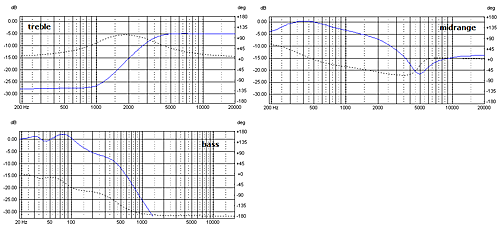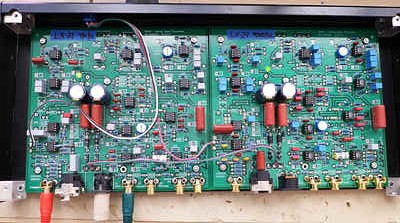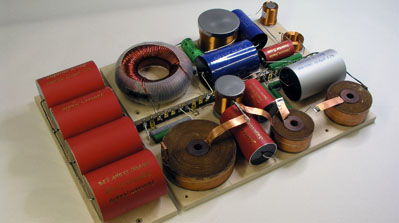|
Electronic crossovers for
loudspeakers
Copyright 2013-24 © Troels Gravesen
A often have the question
why I never use electronic crossovers for my speakers and here are my thoughts:
I do not necessarily subscribe to the notion that
"less is more". Those who settle with a "coil and a cap" often pay a price on certain
performance parametres as no drivers - to my knowledge - are capable of
performing well from such simple measures unless we never play very
loud.
Any loudspeaker crossover, being active or passive, divides the
frequency band between drivers with regard to amplitude and phase and
ensures a balanced presentation of bass, midrange and treble. In
principle as simple as that.
If you want to use an electronic
crossover (analog or digital) for any
of my constructions, you need to replicate the transfer function of my
passive crossover with regard to amplitude and phase, at least if you
want the speaker to sound the same as I made it. Now, what does this mean?
Below the transfer function of the passive crossover for the Jenzen-D:

Click image to view large.
As can be seen, the tweeter crossover transfer function looks pretty
much like a text-book crossover. The midrange not so much with some equalisation
of upper mid and a sharp notch-filter at 5 kHz. The active crossover
needs to do the same thing and if not digital, not so easy to do
actually.
The bass transfer function
display some equalisation around 50-100 Hz as we have an elevated
response around 80 Hz due to the impedance peaks created by the
TL/vented box. This must be dealt with quite differently by an active
crossover as the active crossover sees the linear impedance of the
following amplifier and not the one created by the box tuning, thus
probably no equalisation is needed. I would tune the active bass crossover
section by doing near-field measurements of the bass driver.
The long and the short of it is that in order to implement the transfer
function of the passive crossover we need to be able to measure what
happens, and most people do not have measuring equipment good enough to
do so.
 
To the left an electronic crossover for
Linkwitz-Riley
LX521 speaker and to the right my
Jenzen-D
passive crossover.
Anything between the signal source and the speaker drivers is
likely to leave a mark on overall performance and the question is
whether a well executed passive crossover is doing more harm compared to the signal passing a complex electronic
crossover, being analog or digital. There can be several scenarios:
If using an
analog musical source we need to convert to
digital after the line stage and have the (digital) crossover
divide the signal into bass, mid and treble and further provide the necessary equalisation
to mimic the transfer function of the passive crossover. Next the signals
must be converted back to analog for our (assumed) analog power
amplifiers.
Now, all of this can be done in the digital domain
- including listening to digital music - and feed 6-8 digital
amps before the final conversion to the analog signal driving the
loudspeakers. The all-digital solution
indeed appears more simple compared to the first example.
The active filter seen
on the left hand photo above is an analog filter including the necessary equalisation of drivers' response. I'm not sure the
signal passing quite a number of opamps and less that state of the
art capacitors does better than the high-quality crossover
components seen on the right hand side photo, but some believe that
as long as distortion is low, everything is as good as can be. I
have my doubts.
I did my share of analog electronic crossovers
before this website started and I'm not going this route again. I
like it simple, not for the sake of simple but because I think we
can do as well with passive crossovers - and I like my wife to be able to use
my system as well. I have one really -
really - good amplifier driving my mid-tweeter and having
two of these would be crazy. One can do it when only we use a well
designed passive crossover and premium components.
I do use a
dbx
24 dB LR electronic crossover for experimental purposes when
deciding e.g. point of crossover between bass and mid. Very useful.
And there were experiments that turned out very well with this
dbx crossover, the
AT-SW using
the 10C77 bass
driver and a point of crossover around 140 Hz.
Next I tried the
QUATTRO with
a push-pull U-frame, 35(W) x 65(H) x 60(D) cm, made from two
Eminence Deltalite 2512 drivers connected in series. Again 140 Hz
point of crossover. This system was really smashing and to the full
demonstrated the smooth and linear response of the QUATTRO speaker.
And it could play insanely loud and be a system for those who think
the DTQWT-12 is made for 300 cubic meter rooms, which it is not,
rather 60-100 cubic meters.
I think active
solutions are a good thing for home entertainment when we
deal with seriously inefficient speakers requiring multiple amps -
or feeding a subwoofer from a separate amp.
One area where digital
management is far superior to passive solutions is equalising the
bass response, which by far overshadows most other problems people
have when installing sound systems in a less than ideal acoustic
living space. Too much bass or too little bass is the most common
problem people run into.
My recent experience with
DSP/Plate-amps, ATS4-HE and MUN-17, see
index, has made me consider more constructions based on these
principles. It simply works great!
As in other areas
of hifi, technology easily turns into religion and pointing fingers
is futile.
|


